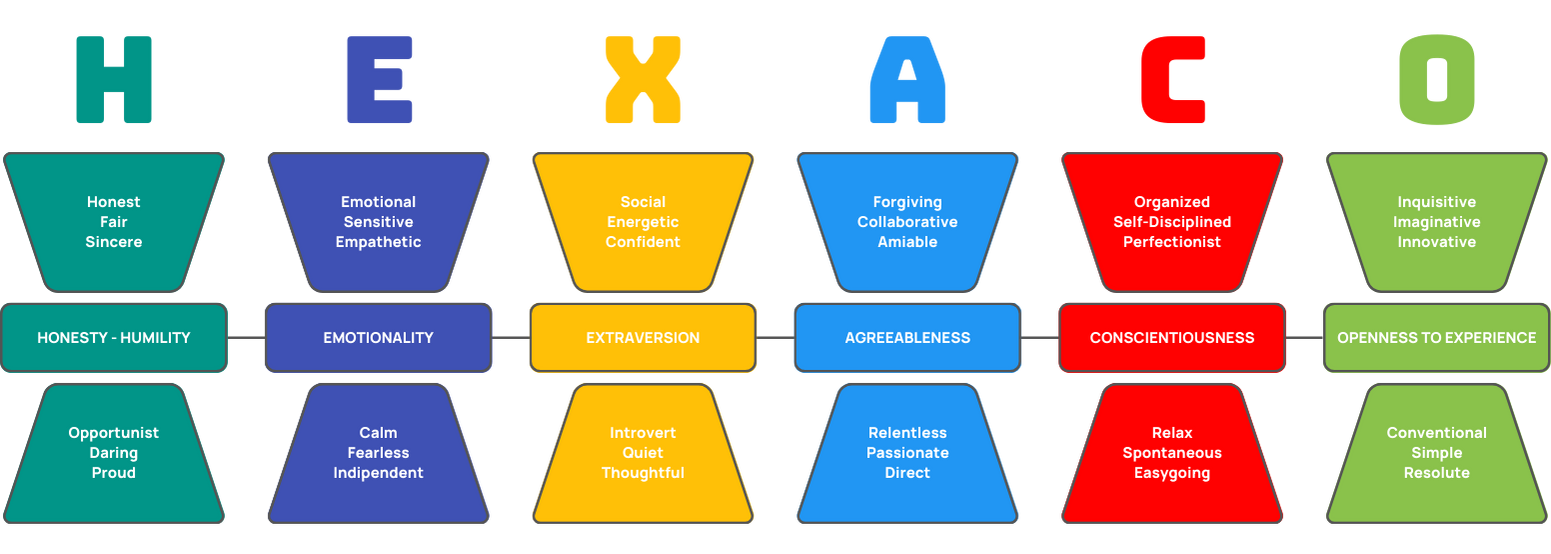
6 Factor Personality Test
Explore Your Identity with Scientifically Proven 6-Factor Personality Test: Uncover Your Traits that Define You and Identify Areas for Personal Growth to Achieve Success.
“The Short Six-Factor Personality Inventory was developed by de Vries (2013) using the items of the HEXACO Personality Inventory through abbreviation procedures, and it has been translated into Turkish by Tatar (2023) and its psychometric properties have been examined.”

In the early 2000s, studies in the field of psychology regarding personality demonstrated the need for an expansion of the personality theory known as the Five-Factor Personality Model or the Big Five Personality Model. This expansion should include a new factor called Honesty-Humility, which was considered a missing aspect. Furthermore, it was suggested that the contents of the Agreeableness and Emotional Stability factors, also present in this personality model, should be reorganized.
In line with this, utilizing a psychological lexicon-based approach and drawing from findings in the field of personality research, the Six-Factor (HEXACO) Personality Model has been developed. This model defines six broad personality domains: Honesty-Humility, Emotionality, Extraversion, Agreeableness, Conscientiousness, and Openness to Experience.
Due to the addition of the newly introduced sixth factor and the reorganization of the components that constitute both the six factors and the factor structure of the Five-Factor Personality Model, the performance of the Six-Factor Personality Model in explaining criteria related to psychological phenomena and behaviors appears to be superior to that of the factors of the Five-Factor Personality Model, as they are empirically distinguishable from each other.
Honesty-Humility Factor: This factor describes qualities such as honesty, sincerity, humility, fairness, loyalty, pretentiousness, two-facedness, greediness, and whether or not someone values themselves. It reflects the levels of self-worth, rule adherence, inclination towards wealth and luxury, importance of social status, emphasis on material gain, manipulating others for personal benefit, and efforts to get along with others.
Emotionality Factor: This factor defines whether a person is sensitive, emotional, fragile, brave, resilient, independent, self-confident, and stable. It shows the levels of anxiety in major life events, willingness to take risks in the face of physical harm, sharing emotions or mood with others, forming emotional connections with others, and the need for emotional support in interpersonal relationships.
Extraversion Factor: This factor defines whether a person is extroverted, lively, outgoing, cheerful, quiet, or shy. It reflects levels of self-confidence, willingness to be the center of social attention, participation in social activities, tendencies toward leadership, self-assuredness in social relationships, enjoyment of social interactions, and comfort in public speaking.
Agreeableness Factor: This factor describes whether a person is agreeable, kind, patient, gentle, obstinate, irritable, or uncooperative. It indicates levels of harboring resentment or forgiveness towards those who harm, avoiding judging or seeing others’ faults, persistently defending one’s opinions, conflict avoidance, anger control, willingness to compromise, and willingness to collaborate with others.
Conscientiousness Factor: This factor defines whether a person is disciplined, organized, methodical, careful, meticulous, negligent, absentminded, or irresponsible. It indicates levels of maintaining one’s physical environment orderly, making careful decisions, persistently pursuing difficult tasks and goals, planning one’s time, planning one’s work, and fulfilling responsibilities accurately and thoroughly.
Openness to Experience Factor: This factor defines whether a person is creative, innovative, inquisitive, intellectual, conventional, or narrow-minded. It indicates levels of showing creative pursuit, being influenced by art, having intellectual curiosity, using imagination freely, appreciating beauty, expressing ideas freely, showing tolerance for the unconventional, and having curiosity for knowledge.
Resources
Ashton, M. C., & Lee, K. (2007). Empirical, theoretical, and practical advantages of the HEXACO model of personality structure. Personality and Social Psychology Review, 11(2), 150–166.
Ashton, M. C., & Lee, K. (2008). The prediction of honesty–humility-related criteria by the HEXACO and Five-Factor Models of personality. Journal of Research in Personality, 42(5), 1216–1228.
Ashton, M. C., Lee, K., Perugini, M., Szarota, P., de Vries, R. E., Di Blas, L., Boies, K., & De Raad, B. (2004). A Six-Factor Structure of Personality-Descriptive Adjectives: Solutions From Psycholexical Studies in Seven Languages. Journal of Personality and Social Psychology, 86(2), 356–366.
de Vries, R. E. (2013). The 24-item brief HEXACO inventory (BHI). Journal of Research in Personality, 47(6), 871-880.
Lee, K., & Ashton, M. C. (2004). Psychometric properties of the HEXACO personality inventory. Multivariate Behavioral Research, 39(2), 329–358.
Lee, K., & Ashton, M. C. (2006). Further assessment of the HEXACO Personality Inventory: Two new facet scales and an observer report form. Psychological Assessment, 18(2), 182–191.
Tatar, A. (2018). Gözden geçirilmiş uzun ve kısa form Altı Faktörlü Kişilik Envanteri (HEXACO-PI-R) Türkçe formunun psikometrik özelliklerinin incelenmesi. Anadolu Psikiyatri Dergisi, 19(Ek 1), 5-13.
Tatar, A. (2021). Uzun form Beş Faktör Kişilik Envanteri ve gözden geçirilmiş uzun Form Altı Faktörlü Kişilik Envanteri faktör yapılarının karşılaştırması. Humanistic Perspective, 3(3), 610-625.
Tatar, A. (2023, yayınlanmamış çalışma). Kısa Altı Faktörlü Kişilik Envanteri-24’ün Türkçe’ye çevrilmesi ve psikometrik özelliklerinin incelenmesi.
Tatar, A., Saltukoğlu, G., Özdemir, H., Bekiroğlu, B., Çelikbaş, B., & Çamkerten, S. (2019). İş performansı ve iş doyumunun yordayıcıları olarak Altı Faktörlü Kişilik Modeli (HEXACO) yapıları. İş’te Davranış Dergisi, 4(2), 68-77.
Thielmann, I., Akrami, N., Babarovic, T., Belloch, A., Bergh, R., Chirumbolo, A., ColoviC, P., de Vries, R.E., Dostál, D., Egorova, M., Gnisci, A., Heydasch, T., Hilbig, B. E., Hsu, K., Izdebski, P., Leone, L., Marcus, B., Mededovic, J., Nagy, J., Parshikova, O., Perugini, M., Petrovic, B., Romero, E., Sergi, I., Shin, K., Smederevac, S., Šverko, I., Szarota, P., Szirmák, Z., Tatar, A., Wakabayashi, A., Wasti, S. A., Záškodná, T., Zettler, I., Ashton, M. C., & Lee, K. (2020). The HEXACO-100 across 16 languages: a large-scale test of measurement invariance. Journal of Personality Assessment, 102(5), 714-726.